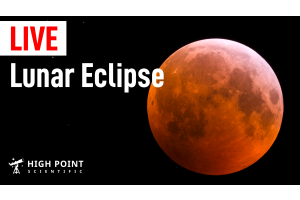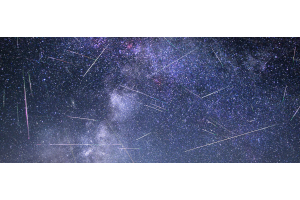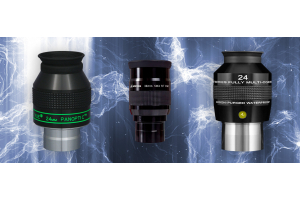
WARNING: At no point should you ever look at the Sun without a solar filter, especially through a telescope. Doing so could cause permanent damage to your eyes! Instead, use a professionally manufactured filter at all times.
A total solar eclipse is one of the most incredible astronomical events a person can experience, and thousands dedicate their time and energy to traveling around the world to experience one. Photographing a solar eclipse can be challenging, but this article will serve as a beginner’s guide to getting the most out of your equipment and producing an image that will help you relive the experience in the years to come.
What is a Solar Eclipse?
Put simply, a solar eclipse occurs when the Moon passes in front of the Sun, blocking its light. Thanks to an incredible coincidence, the Moon appears roughly the same size as the Sun in our sky, and when aligned perfectly, the Moon covers the Sun’s disc and we witness an eclipse. A total solar eclipse can also reveal, in stunning detail, the different layers of the Sun’s atmosphere that would otherwise remain invisible from the ground. There are several types of solar eclipses one can see, each of them possessing its own unique beauty.
Partial Solar Eclipse
As the name implies, a partial solar eclipse occurs when the Moon only partially covers the disc of the Sun. A partial eclipse can be seen under two circumstances:
- If the Sun and Moon are not in perfect alignment, and
- If you’re outside the path of totality
Annular Solar Eclipse
An annular solar eclipse occurs when the Moon eclipses the Sun while at its furthest point from Earth (known as its “apogee”). When this happens, the Moon appears just a little too small to entirely cover the Sun’s disc, and we see a phenomenon known as the “ring of fire” instead.
Total Solar Eclipse
A total solar eclipse is what everyone imagines when they hear the words “solar eclipse”. This occurs when the Moon completely covers the disc of the Sun and casts a shadow on the surface of the Earth. As this happens, anyone within the path of totality is plunged into darkness for the brief time it takes the Moon to pass in front of the Sun.
Different parts of the Sun’s atmosphere, such as the chromosphere and corona, that are normally invisible to the naked eye, also become visible. In particular, the corona appears as a ghostly white glow around the darkened disc of the Sun. Stars appear in the middle of the day; planets like Jupiter and Venus will be obvious in the sky, and even the Milky Way has been known to make an appearance.
A careful observer can also spot “prominences” around the limb (or edge) of the Moon; these are extremely hot filaments of ionized gas, larger than the planet Jupiter, extending away from the Sun.
Hybrid Solar Eclipse
A hybrid eclipse is a very rare type of eclipse which allows for both an annular and a total solar eclipse to be seen, depending on your location along the path of totality. More specifically, those located at the start or end of the path will witness an annular eclipse, whereas those located near the center will experience a total eclipse. These types of eclipses only occur two or three times a century.
 Click to Enlarge Image
Click to Enlarge Image
 Click to Enlarge Image
Click to Enlarge Image
 Click to Enlarge Image
Click to Enlarge Image
Which Solar Filter Should I Use?
During the partial phases, both before and after totality, a solar filter is critical to safely observe a solar eclipse. The only time you should observe the Sun without a filter is during those few moments of totality, when the light of the Sun is 100% blocked by the Moon.
Solar filters are usually made of material, such as mylar, that blocks the vast majority of the Sun’s light, making it safe to observe. However, even with a solar filter, you may find the image of the Sun through a large telescope to be uncomfortably bright.
There are two main types of eclipse filters: an off-axis filter and a full-aperture filter.
- Off-axis filter: recommended for those using larger telescopes, such as larger Newtonian and Schmidt-Cassegrains, as they block off most of the aperture from the Sun, reducing the brightness as a result.
- Full aperture filter: recommended for those observing or imaging the eclipse through smaller telescopes, such as refractors.
You might also consider using a white light solar filter. These enable you to observe the Sun in a more accurate, neutral-white color instead of the deep orange color created by other filters. The AstroZap Visual Baader Solar Filters are ideal for this purpose, as they use the Baader AstroSolar Safety Film to safely observe the Sun in neutral colors.
Lastly, you may prefer to use a glass filter instead of film, as glass filters are far less susceptible to tears or punctures, and Spectrum Glass Solar Filters are a fantastic choice to enhance your enjoyment of the eclipse.
Before purchasing your filter, you should first measure the exterior diameter of your optical tube assembly (OTA) to ensure a good fit. While we offer returns on glass solar filters, we do not offer returns on solar filters made of film, so you need to ensure the exterior diameter of your telescope is correctly measured. If you’re unsure how to do this, please reach out to our gear experts for assistance.
Planning for the Solar Eclipse
Finding the Right Mount and Telescope
If you’re looking to take photos of the eclipse, we strongly recommend purchasing a portable setup that’s capable of tracking the sky. Being portable, it can easily be transported to your primary observing location, and if the weather turns against you, you can quickly relocate and set up again.
A great example is the Sky-Watcher SolarQuest Alt-Azimuth Solar Mount. This lightweight, highly capable mount comes with built-in GPS and Helio-Find technology that can automatically locate the Sun in the sky. Additionally, the mount comes with a payload weight of 11 lbs, enabling you to use a smaller telescope like the Apertura 60EDR, the Coronado PST Personal Telescope (great for partial and annular eclipses), the Sky-Watcher Skymax 90mm, and many others.
(Please note that while the payload weight is 11 lbs, for ease of use you should keep the payload weight to about half that amount, including the weight of your DSLR, finder, et cetera.)
Should I use a DSLR or can I just use my smartphone?
Now that you’ve identified a mount and telescope to use, it’s time to think about what type of photograph you’d like to take.
It’s possible to get decent photographs of any solar eclipse with your smartphone camera, as the camera app will automatically adjust for the proper exposure. You will, however, need an adapter to attach your smartphone to the eyepiece, and we recommend the Celestron NexYZ Universal smartphone adapter for this purpose.
Better yet, if you have the option, we strongly recommend using a DSLR to photograph solar eclipses, as the ability to quickly adjust the exposure and its easy attachment to a telescope will save you significant headaches. With this in mind, please note the rest of the article will assume that you’re using a DSLR to photograph the eclipse.
How will I know when the eclipse starts for my area?
If you’re looking to photograph the eclipse, you’ll need to know when the eclipse will begin and end. Online tools, such as TimeAndDate’s eclipse page, will provide you with the exact timings for your location. Additionally, planetarium software, such as Stellarium and SkySafari, are also able to provide you with the details for the your specific location.
Photographing a Partial or Annular Solar Eclipse
Once you know which setup you’re using and the time the eclipse starts, you should consider the best settings for the partial phase of the eclipse. Remember, even though the filter will block out most of the light from the Sun, it will still be quite bright.
You should therefore keep the camera’s ISO relatively low (around 100) and keep the exposure very short (1/4000 to 1/2000). This will be enough to capture the disc of the Sun without overexposing it. If you’re looking to do a timelapse, aim to take a fresh exposure every 5 minutes to see the eclipse progress. (You can also use the same ISO and exposure settings to capture an annular eclipse.)
Remember, at no point during the partial phase should you remove your solar filter from the front of your telescope!
Photographing a Total Solar Eclipse
If you’re fortunate enough to be in the path of totality, you could have anywhere up to five minutes to capture stunning details in the Sun’s atmosphere. These different features can be captured by adjusting your exposure and getting the timing just right. IMPORTANT: During totality, it is safe for you to remove your solar filter, and if you forget, you’ll miss out on capturing some great images of the eclipse! This is the only point during a solar eclipse where it’s safe to remove a filter while looking at the Sun.
Baily's Beads
Baily's beads occur just moments before second contact (or the point where the disc of the Moon fully eclipses the Sun) - just as you’re probably removing your filter. Fortunately, you can keep the same settings you used for the partial phase to capture this phenomenon. Baily’s beads are caused by bright sunlight passing through valleys and hills along the edge of the lunar surface, giving rise to glowing beads around the Moon’s darkened disc.
Solar Chromosphere
The chromosphere is a deep-red layer of the Sun’s surface right above the Sun’s photosphere, and it marks the transition region to the Sun’s corona. It’s normally invisible due to the brightness of the Sun, but during an eclipse, it’s visible around the edge of the Moon. You can keep the same settings you were using for Baily's beads and the partial phase to capture them (low ISO, very short exposure time).
Solar Corona
The solar corona is the next layer of the Sun’s atmosphere that is visible during an eclipse. It’s a pretty faint layer of the Sun, but it’s absolutely huge. Additionally, while the corona is not very dense, it is incredibly hot, with temperatures over 1,800,000 degrees Fahrenheit! To capture the corona, you’ll need to increase your exposure time to around one to two seconds. A longer exposure will capture more of the corona.
Earthshine
Earthshine is the reflection of light from the Earth onto the darkened portion of the Moon’s surface, and it appears slightly bluish in hue. You may have seen this already on the crescent Moon when it appears in the evening or morning twilight, three or four days before or after the new Moon.
To capture earthshine, you’ll need to up your exposure time to more than five seconds. At this point, you could also capture some background stars!
Other Tips
Shutter Speed Calculator for Solar Eclipses
If you want to remove the guesswork for the exposure during any part of the eclipse, check out Xavier M. Jubier’s Solar Eclipse Time Exposure Calculator. It’s a fantastic tool that can calculate the exposure required for the perfect shot, and it can save you a lot of hassle by calculating all the necessary settings in advance.
Automating Your Eclipse Photography
If you don’t want to be staring at the eclipse through your camera viewfinder the entire time, consider using software to automate your photography. That way, you can enjoy the eclipse while still capturing some stunning images!
The best software for a Mac is Solar Eclipse Maestro; it’s free, it can be used with most Canon and Nikon cameras, and it will enable you to precisely calculate the exact shutter speed and ISO for your setup for the best images possible. Unfortunately, it is only compatible with Mac OSX, specifically those versions released before Catalina.
Meanwhile, PC owners with Windows 7 or newer can use Moonglow Technologies’s Eclipse Orchestrator to automate their eclipse photography.
Just Have Fun!
Lastly, the most important tip for photographing a solar eclipse: have fun! We’ve presented a lot of information here, and some of it may be overwhelming, so if you’ve never photographed an eclipse before, just try to get the best image of totality you can.
Whatever you do, don’t spend the entire time behind the viewfinder! An eclipse is an experience that is felt with all the senses, not just what you see through the camera lens. In fact, if this is your first eclipse, you might not even want to bother with taking a photograph at all! Just sit back, relax, and enjoy the incredible sight and feeling of the Moon’s shadow as it falls upon you. (To learn more about solar eclipses and what you can expect, be sure to check out our guide!)
Click the arrow above to see MLA, APA, and Chicago Manual of Style citations.
MLA:
Denny, Kyle. "How to Photograph a Solar Eclipse," AstronomyHub, High Point Scientific, 18 Jul. 2023, https://www.highpointscientific.com/astronomy-hub/post/how-to-photograph-a-solar-eclipse.
APA:
Denny, K. (2023, July 18). How to photograph a solar eclipse. High Point Scientific. https://www.highpointscientific.com/astronomy-hub/post/how-to-photograph-a-solar-eclipse
Chicago Manual of Style:
Bibliography:
Kyle Denny. "How to Photograph a Solar Eclipse," AstronomyHub (blog), High Point Scientific, July 18, 2023. https://www.highpointscientific.com/astronomy-hub/post/how-to-photograph-a-solar-eclipse.
Footnote:
Kyle Denny, "How to Photograph a Solar Eclipse," AstronomyHub, High Point Scientific, July 18, 2023, https://www.highpointscientific.com/astronomy-hub/post/how-to-photograph-a-solar-eclipse.
This Article was Originally Published on 06/8/2021












